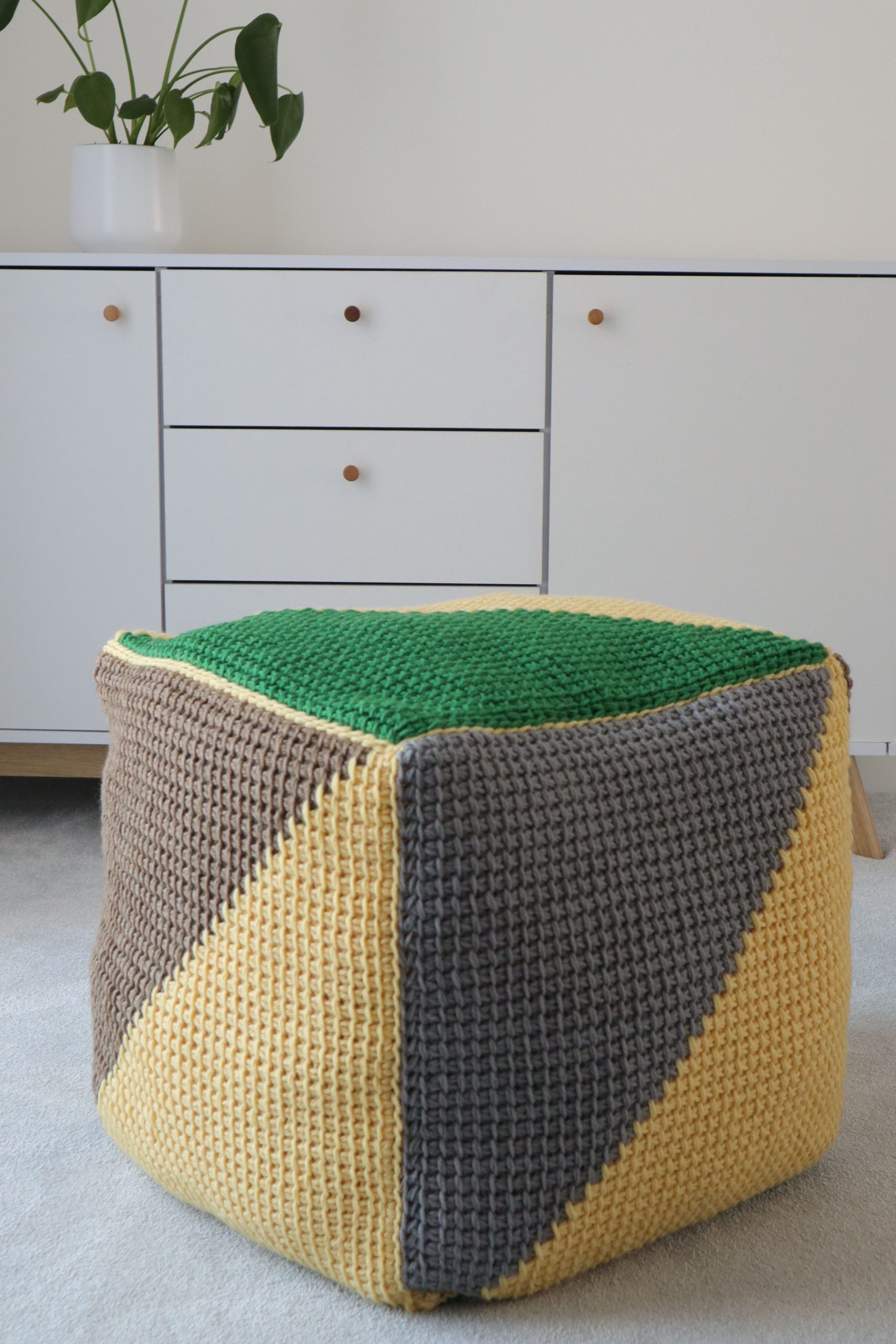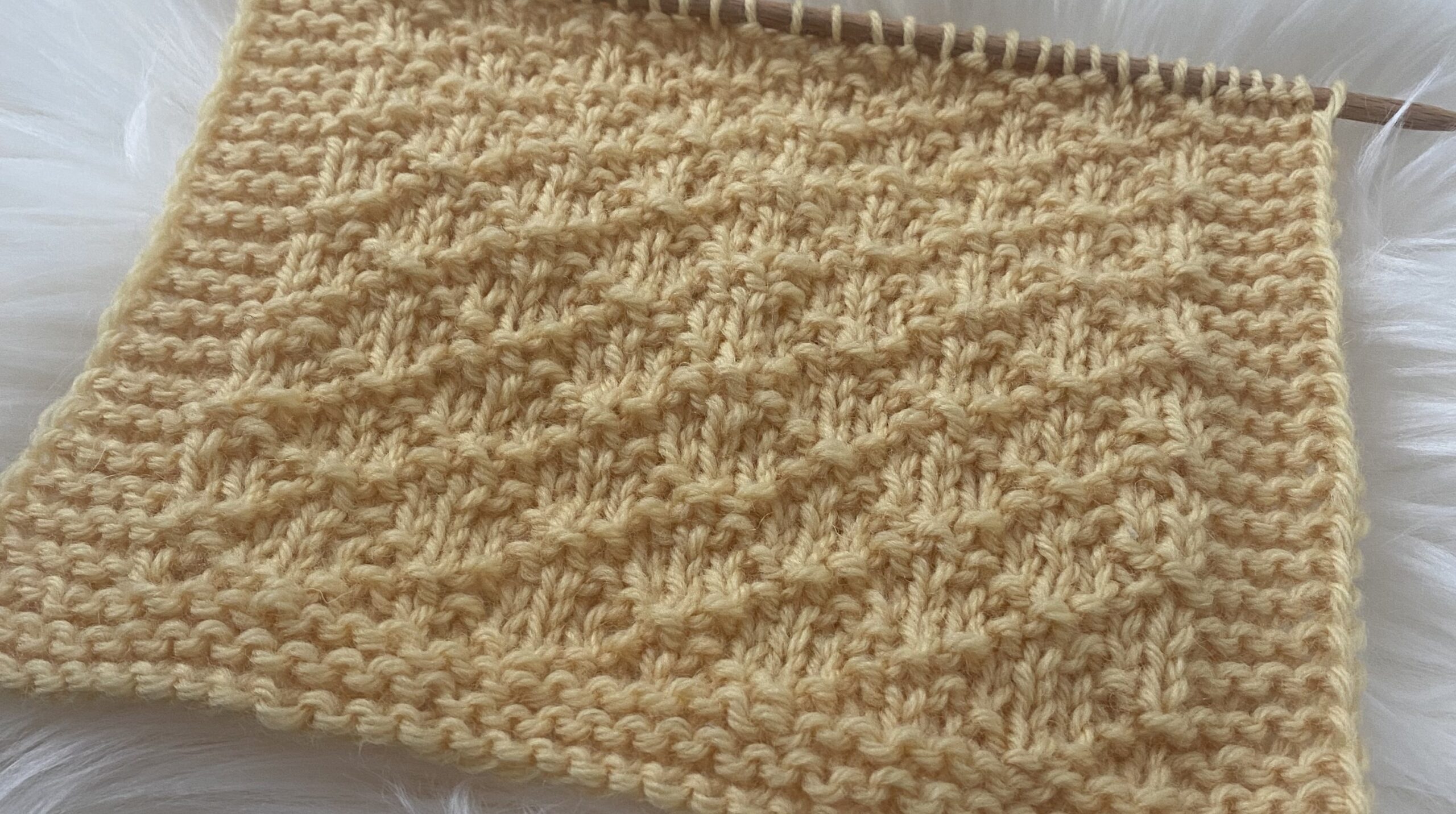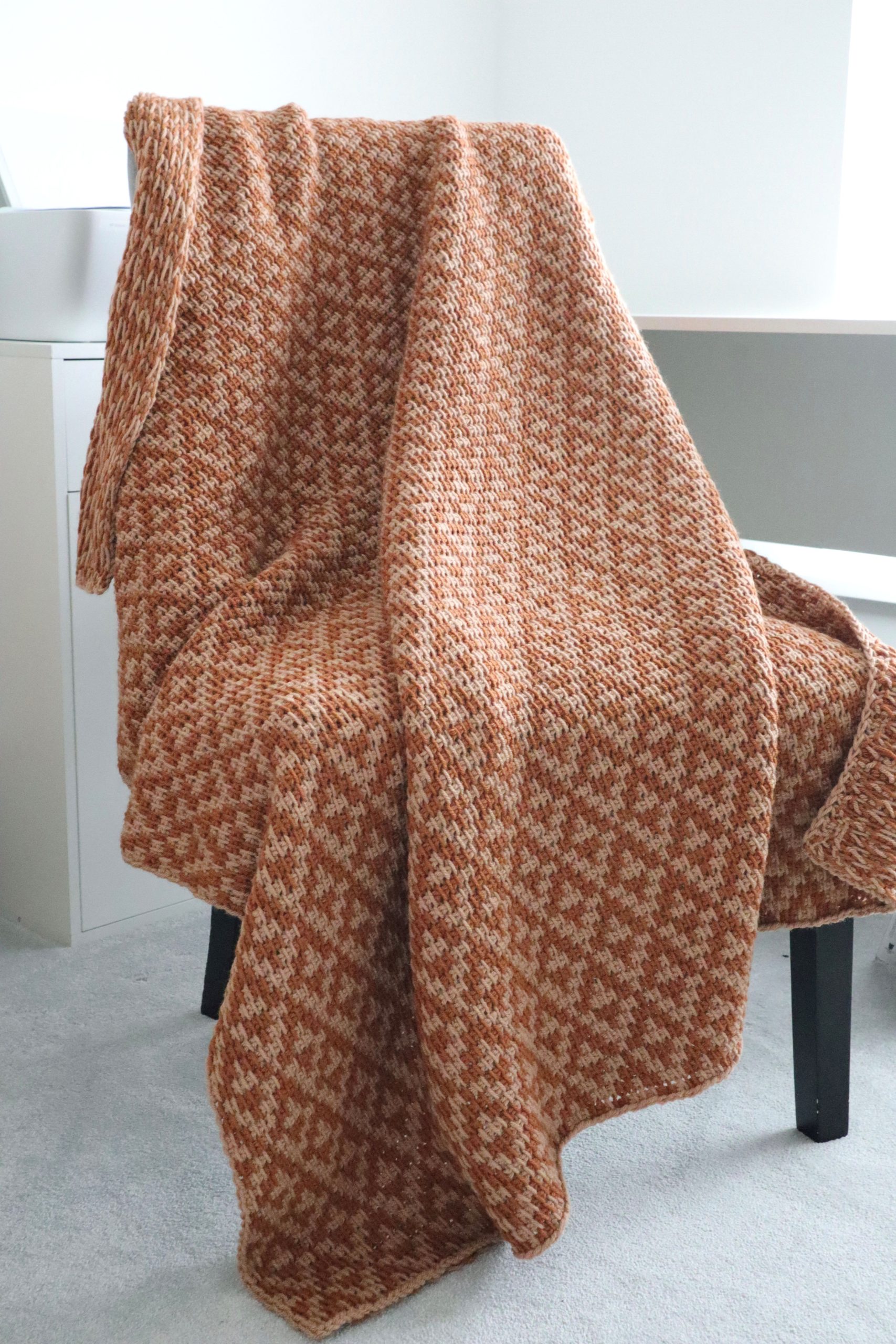The Cottage Pouffe is a beginner friendly Tunisian crochet pouffe project that can be made in a couple of evenings. It is a beautiful home décor item that will spice up any sitting area. Lay back on your sofa, put your feet up and enjoy some quality crochet time with this project!
Last updated: 21/04/2024
You can purchase the add free PDF version of the pattern at LoveCrafts here and Ravelry here.
This site contains affiliate links to products. We may receive a commission for purchases made through these links at no extra cost to you. This helps to cover the running cost of the website and enables me to continue making free patterns.
Please NOTE that this pattern is subject to copyright and is my intellectual property. The online version is for personal use only. Do not re-publish or sell this pattern in part or full or make video tutorials of it. Any such actions are a breach of copyright and can result in legal action.

Skills required:
To create this beautiful crochet pouffe you will need to master (or already know) these stitches and techniques:
Chain, Tunisian crochet technique (alternating forward and return passes), Tunisian simple stitch (tss), Tunisian crochet colourwork (intarsia), Tunisian simple stitch bind-off, Locking Mattress Stitch, blocking.
Skill level:

Finished measurements:
The final crochet pouffe measurements (blocked, per panel):
40.75 cm x 40.75 cm (approx. 16” x 16”)
Materials and tools
To get the exact look as on the pictures of my crochet pouffe, you will need:
We Crochet Wool of the Andes (100% Peruvian Highland Wool | Worsted weight | 50 g (1.76 oz) = 91 m (110 yds)), (#25975) Crème Brulee 10 skeins (A), (#23439) Grass 4 skeins (B), (#24075) Camel Heather 4 skeins (C), (#25977) Silver 4 skeins (D)

Tunisian crochet hook size 8.0 mm (L/11) with cable (at least 25.5 cm (10”)) or size to obtain the gauge
Fiberfill
15” zipper (optional)
Tapestry needle
Scissors
You can get your craft supplies here.

Gauge:
Blocked Gauge:
10 sts x 9 rows = 10 x 10 cm (4 x 4”) over tss
Gauge helps you to understand how the project turns out in terms of the final size. If you would like to achieve the exact size of the final project as in the instructions above, you gauge needs to match exactly to the above.
If you get more stitches and/or rows than stated above using the exact hook size as per instructions, your final project will turn out smaller. Conversely, if you get less stitches and/or rows than stated above using the exact hooks size as per instructions, your final project will turn out bigger.
To make adjustments, if you get more stitches and/or rows, you can try using bigger hook size to get closer to the desired size. Conversely, if you get less stitches and/or rows, you can try using smaller hook size to get closer to the desired size.
It may take trial and error to try out a few hook sizes to achieve the exact size.
Alternatively, if you really don’t want to make several samples to achieve the desired size, you can try to alter your tension as you work the project. However, I would advise to try this out once you master the basics of Tunisian crochet as it may be a bit tiresome to try to master the basics of Tunisian crochet and focus on alternating your tension while working the project.
Stitch guide:
Tunisian crochet stitches are worked in 2 steps; forward and return pass from right to left, with the number of sts (lps) increasing on the hook during the forward pass and decreasing during the return pass.
Standard Return pass is worked in the same way for all stitches (rows of sts) used in this project as follows: 1 ch, * yrh, draw through 2 lps on hook, rep from * until 1 lp on hook.
Edge stitches:
Right edge stitch- This is the first lp on hook and counts as first st unless otherwise stated.
Left edge stitch- This st is referred to in the pattern as the End Stitch (ES) and is crocheted as follows: Rotate the end of the fabric towards yourself, insert the hook under both bars (left and right) of the last st, yrh and pul.
- First row of Tunisian crochet: Insert the hook in the back bump of second ch from hook, yrh and pul across.
- Tunisian simple stitch: Insert the hook from right to left under front vertical bar of the next st, yrh and pul.
Changing colours (intarsia): When changing the colours within a row in Tunisian crochet, place the new strand of yarn over the old strand. This locks the old colour in place and prevent gaps occurring between the different colour sections.
Tunisian Simple stitch bind-off: Insert hook from right to left under front vertical bar of the next st, yrh, pul and pull through the lp that is on the hook. One lp remains on the hook.
Locking Mattress Stitch
- Place the pieces RS down with edges aligned side by side. Stitches will be worked through the bottom lps of each edge.
- Start the seam by inserting the needle from left to right through the first stitches of both panels at the bottom.
- Move one stitch up on the right side, insert the needle from right to left and continue to the first stitch on the left side (the one already worked into).
- Move one stitch up on the left side, insert the needle from left to right and continue to the last stitch worked into on the right side.
- Repeat steps 3 and 4 to end.
- Weave in ends.

If this is your first Tunisian crochet project and are not sure if this blanket matches your skills, I have a Tunisian crochet masterclass tutorial that will jump-start your Tunisian crochet journey!
| Abbreviations: | |
| ch- chain | yrh- yarn round the hook |
| st(s)- stitch(es) | pul- pull up a loop |
| lp(s)- loop(s) | FP- forward pass |
| tss- Tunisian simple stitch | RP- return pass |
| RS- right side | approx.- approximately |
| ES- End stitch | rep- repeat |
Notes:
Similar worsted weight yarns may be substituted; please check gauge.
Number of lps on hook equals number of sts.
Pattern is worked holding 2 strands of yarn throughout.
When changing colours, place the pair of new strands over the old (both on FP and RP) to avoid holes in the project.

Instructions:
Panel (make 6, 2 A/B, 2 A/C, 2 A/D)
With A, ch 40.
Row 1 FP: Insert the hook in the back bump of second ch from hook, yrh and pul, * insert the hook in the back bump of the next ch, yrh and pul; rep from * across to last 3 chs, with B (C, D), pul in back bumps of last 3 chs. 40 lps on hook.
Row 1 RP and all other RPs: Standard RP.
Row 2: Tss in each st across to last 4 sts, with B (C, D), tss in next 3 sts, ES in last st.
Row 3: Tss in each st across to last 5 sts, with B (C, D), tss in next 4 sts, ES in last st.
Row 4: Tss in each st across to last 6 sts, with B (C, D), tss in next 5 sts, ES in last st.
Rows 5-35: Continue working in established pattern of reducing number of tss in A by 1 and increasing the number of tss in B (C, D) by 1.
Row 36: Tss in next 2 sts, with B (C, D), tss in each st across to last st, ES in last st.
Row 37: In A, Tss bind-off.
Fasten-off.

Finishing:
Weave in all ends and block to final measurements as in schematic.
Arrange panels as per diagram.
Using Locking Mattress Stitch or preferred method, sew together, leaving small opening, stuff to desired firmness.
Sew remaining opening closed.
Alternatively, if using zipper, leave 1 side on bottom unsewn, sew zipper in center 15”, using Locking Mattress Stitch or desired method, sew remaining 1” on each side.
Fasten off, weave in any remaining ends.
I would love to see and share your work on social media, use #cottagepoufee or #exquisitecrochetuk.
Pattern support: exquisite.crochet.uk@gmail.com
Further resources:
Pattern video tutorial:
Diagram:

For endless crochet inspiration, you can subscribe to AllFreeCrochet website here.
If you prefer to have all your craft inspiration in one place, FaveCrafts is definitely the place to go. Why not subscribe to their newsletter here so you would not miss a thing!
You can purchase the add free PDF version of the pattern at LoveCrafts here and Ravelry here.
You can get your We Crochet Wool of the Andes Worsted here.
Did you enjoy the Cottage Pouffe pattern? Why not try my other crochet home decor patterns:




Thank you so much if you got this far in the pattern! I hope you got inspired for your own version using various colours. I can’t wait to see it! Don’t forget to tag me on Instagram and let me know in the comment section below how you got on with it! As always, if you have any pattern query, the quickest way to get it answered is by emailing me on the pattern support email address above.
Happy crocheting!




